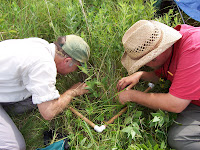Vitaceae Seedlings; A Mystery No More

Sampling plants in quadrats is a challenging endeavor. It requires a taste for botany in its most raw and primitive state. Plants encountered in quadrats are almost always sterile and range from newborn seedlings to the withered remains of plants that may have senesced earlier in the year; and everything green in between. The field botanist spends countless hours in a growing season on his knees, head buried in vegetation, straining to use a hand lens at ground level in order to examine such subtleties as the red calluses on the teeth of Ceanothus americanus seedlings or the length of the ligule that separates Andropogon virginicus from Andropogon scoparius ( Schizachyrium lacks taxonomic credibility when applied to Little Bluestem). All this with the discomfort and sometimes fear that ticks, chiggers, horseflies, deerflies, yellow jackets, mosquitoes, gnats, spiders, snakes, falling limbs, storms, poison-ivy, heat and meth-heads illicit all around you. You know you have reached...
